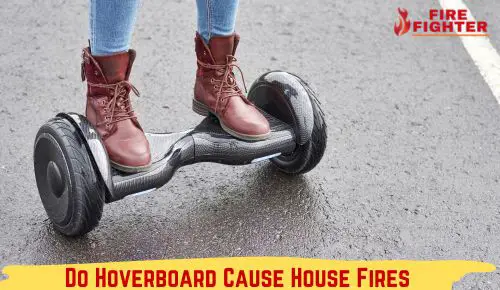Do Hoverboard Cause House Fires?
In recent years, hoverboards have become a popular mode of transportation for people of all ages.
They are sleek, fun, and convenient.
However, as with any new technology, there have been concerns raised about their safety. One of the biggest concerns is whether or not hoverboards can cause house fires.
While there have been reports of hoverboards catching fire, the question remains: is it the hoverboards themselves that are to blame, or is it something else entirely?
In this blog post, we will examine the issue in more detail and try to determine whether or not hoverboards are a fire hazard.
Contents
What is Hoverboard?
A hoverboard is a type of self-balancing electric scooter consisting of two wheels connected by a platform. It is designed to be ridden in a standing position and is controlled by the rider’s movements, using sensors and gyroscopes to maintain balance and direction.
Despite its name, a hoverboard does not actually hover, but rather uses wheels to move on the ground. Hoverboards became popular in the early 2010s and were commonly used as a form of personal transportation.
However, due to safety concerns and reports of fires caused by malfunctioning batteries, many countries have restricted their use and sale.
Do Hoverboard Cause House Fires
In 2015, there were numerous reports of hoverboard fires, and the Consumer Product Safety Commission (CPSC) launched an investigation.
The investigation found that the majority of the hoverboard fires were caused by the lithium-ion batteries. The CPSC issued a recall of over 500,000 hoverboards that did not meet safety standards.
Hoverboard fires continue to be a concern, and there have been several high-profile incidents in recent years.
In 2017, a family in Louisiana lost their home in a fire caused by a hoverboard.
In 2018, a hoverboard caused a fire in a Pennsylvania home, resulting in the death of a three-year-old girl.
So, how can you prevent a hoverboard fire in your home?
The first step is to make sure that you purchase a hoverboard that meets safety standards. Look for hoverboards certified by the Underwriters Laboratories (UL).
The UL certification ensures that the hoverboard has been tested and meets safety standards.

Following the manufacturer’s instructions for charging the hoverboard is also important.
Overcharging the battery can cause it to catch fire.
Never leave a charging hoverboard unattended, and do not charge the hoverboard overnight or while you are sleeping.
When using the hoverboard, make sure that you do not ride it near flammable materials, such as curtains or upholstery.
If the hoverboard starts to smoke or catch fire, move it away from anything that can catch fire and call 911 immediately.
How to Prevent Hoverboard Fires
Hoverboard fires can be prevented by following some basic safety guidelines:
Purchase a high-quality hoverboard from a reputable manufacturer. Look for certifications like UL 2272 to ensure the hoverboard meets safety standards.
Do not overcharge your hoverboard. Follow the manufacturer’s instructions for charging time, and do not leave the hoverboard charging overnight.
Do not use aftermarket chargers or batteries not designed for your hoverboard. Always use the charger that comes with your hoverboard.
Protect your hoverboard from flammable materials such as blankets, cushions, and paper.
Do not ride your hoverboard on uneven or rough terrain. This can cause the battery to short circuit.
Avoid exposing your hoverboard to extreme temperatures. Do not store it in a hot car or leave it outside in cold weather.
Inspect your hoverboard regularly for damage, such as cracks or loose parts. Do not use a damaged hoverboard.
Follow the manufacturer’s guidelines for weight limits and recommended age ranges.
By following these guidelines, you can help prevent hoverboard fires and ensure the safe use of your hoverboard.
Cause Of Hoverboard Fires
Hoverboard fires can be caused by several factors, including:
Overcharging: Leaving a hoverboard plugged in for an extended period or using an aftermarket charger can cause the battery to overcharge and potentially catch fire.
Poor-quality batteries: Hoverboards with low-quality or counterfeit batteries that don’t meet safety standards can be prone to overheating and catching fire.
Manufacturing defects: Hoverboards poorly designed or manufactured with low-quality materials can pose a fire risk.
Rough use: Hoverboards ridden on uneven terrain or subjected to impacts can damage the battery or internal components, leading to fires.
Exposure to extreme temperatures: Storing a hoverboard in a hot car or leaving it outside in cold weather can cause the battery to malfunction and potentially catch fire.
Improper use: Overloading the hoverboard with too much weight, riding too fast, or performing stunts can cause the battery to overheat and catch fire.
It’s important to note that hoverboard fires are rare, and following safety guidelines can help prevent them from occurring.
If you own a hoverboard, it’s important to use it responsibly and keep it in good condition to ensure safe use.
Percentage Of House Fires Caused By Hoverboard
According to a study by the National Fire Protection Association (NFPA), hoverboards caused an estimated 2,500 fires between 2015 and 2018.
These fires resulted in over $90 million in property damage and dozens of injuries.
So, what about hoverboards make them so prone to causing fires? One of the main issues is the lithium-ion batteries that power them.
When these batteries are damaged or overcharged, they can overheat and catch fire. This is particularly true for cheaper, lower-quality hoverboards that may not have proper safety features.
In addition to battery issues, other factors can contribute to hoverboard fires.
For example, leaving a hoverboard plugged in for too long or charging it with a non-approved charger can increase the fire risk.
Additionally, using a hoverboard on a surface that is not flat or that has debris on it can cause the device to malfunction and potentially catch fire.
So, what can you do to protect yourself and your home from hoverboard fires? The first step is to purchase a high-quality hoverboard from a reputable manufacturer.
Look for models with safety features such as overcharge protection and temperature control. It’s also important to use only approved chargers and never leave a hoverboard charging unattended.
If you already own a hoverboard, follow all safety guidelines and instructions provided by the manufacturer.
Avoid using the device on uneven or debris-filled surfaces; never leave it plugged in or charging for longer than recommended.
Is Hoverboard Fire Hazard
Hoverboards have been associated with fire hazards, particularly during the earlier years of their popularity. However, improvements in safety standards and regulations have helped reduce the risk of fire incidents. It is crucial to note that not all hoverboards are the same, and the safety and quality of individual models can vary.
The primary fire hazard associated with hoverboards is related to the lithium-ion batteries used to power them. If the battery is of low quality or damaged, it can overheat, catch fire, or explode. To mitigate these risks, it is important to follow these safety precautions:
Purchase from reputable sellers: Buy hoverboards from reputable manufacturers or authorized retailers to ensure they meet safety standards and have undergone proper testing.
Check for safety certifications: Look for hoverboards that are UL 2272 certified. This certification ensures that the electrical system, including the battery, has been tested for safety.
Avoid overcharging: Do not leave the hoverboard plugged in for extended periods or overnight. Overcharging can lead to battery issues and increase the risk of fire.
Proper storage and charging: Store and charge the hoverboard in a cool, dry area away from flammable materials. Follow the manufacturer’s instructions for charging to prevent any issues.
Regular inspections: Inspect the hoverboard for any signs of damage, such as frayed wires or bulging batteries. If you notice any issues, discontinue use and seek professional assistance.
What To Do If Your Hoverboard Catches Fire
If your hoverboard catches fire, the most important thing is to act quickly to prevent the fire from spreading and causing further damage. Follow these steps:
Move away from the hoverboard: If your hoverboard catches fire, move away from it as quickly as possible to avoid injury. Do not try to pick it up or move it.
Call for help: Call the fire department immediately to report the fire and get assistance.
Use a fire extinguisher: If you have a fire extinguisher nearby and know how to use it, try to put out the fire. Do not use water to extinguish an electrical fire.
Evacuate the area: If the fire is spreading or becoming uncontrollable, evacuate the area and wait for the fire department to arrive.
Do not attempt to put out the fire with water: Water can cause the fire to spread and make the situation worse. Do not use water to try to extinguish an electrical fire.
Wait for the fire department to arrive: When the fire department arrives, let them take control of the situation. Follow their instructions, and do not try to put out the fire yourself.
Remember that hoverboard fires are rare, but it’s important to take safety precautions to prevent them from happening. Always follow manufacturer guidelines for charging and use, and inspect your hoverboard regularly for signs of damage or wear.
Is Hoverboard Catch On Fire
There have been instances of hoverboards catching on fire, although such incidents are relatively rare. Hoverboards are self-balancing scooters that gained popularity in recent years. The main fire risk associated with hoverboards is due to issues with their lithium-ion batteries.
Poorly designed or manufactured batteries, improper charging practices, or using counterfeit or low-quality hoverboards can increase the risk of battery malfunctions and fires.
To minimize the risk of hoverboards catching on fire, it is important to purchase hoverboards from reputable manufacturers, ensure they meet safety certifications, and follow the manufacturer’s instructions for charging and usage.
Additionally, avoid overcharging the battery, monitor the hoverboard while it is charging, and store it away from flammable materials. Regularly inspecting the hoverboard for any signs of damage or battery issues is also recommended.
It’s crucial to be cautious and aware of the potential fire risks associated with hoverboards to ensure safe usage.
Conclusion
Hoverboards have been known to cause house fires due to issues with their batteries, chargers, or wiring.
The risk of hoverboard fires can be minimized by purchasing high-quality hoverboards from reputable manufacturers, using the correct chargers and batteries, and following safety guidelines such as not overcharging the hoverboard, keeping it away from flammable materials, and inspecting it for damage regularly.
It is also important to follow proper procedures in case a hoverboard fire does occur, such as evacuating the area, calling the fire department, and not using water to extinguish an electrical fire.
While hoverboard fires can happen, the risk can be mitigated with responsible use and maintenance.

Hi, I m Aaron Smith, a firefighter, and creator of Firefighterline.com, a website that provides top-notch training courses for firefighting organizations. After completing my studies, I quickly rose through the fire service ranks, eventually becoming Captain at one of the busiest fire departments in the state.
